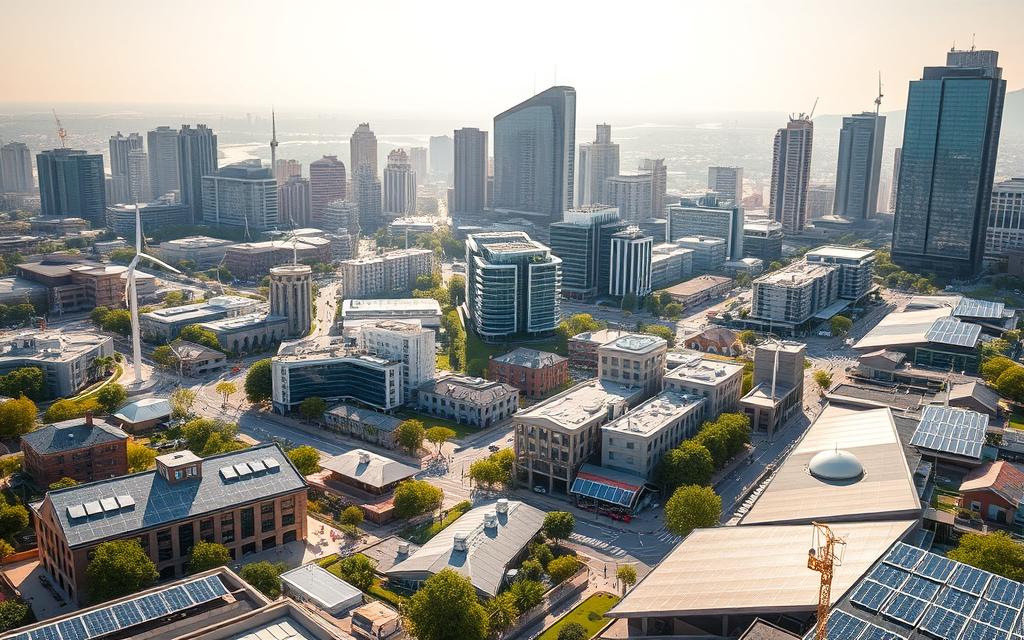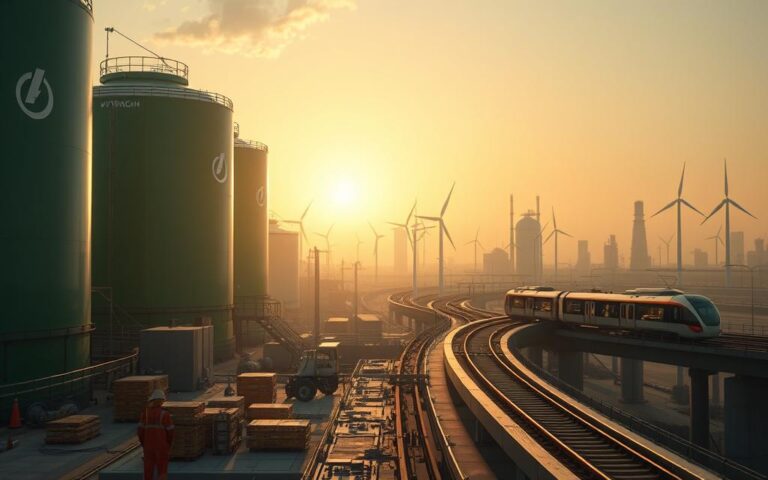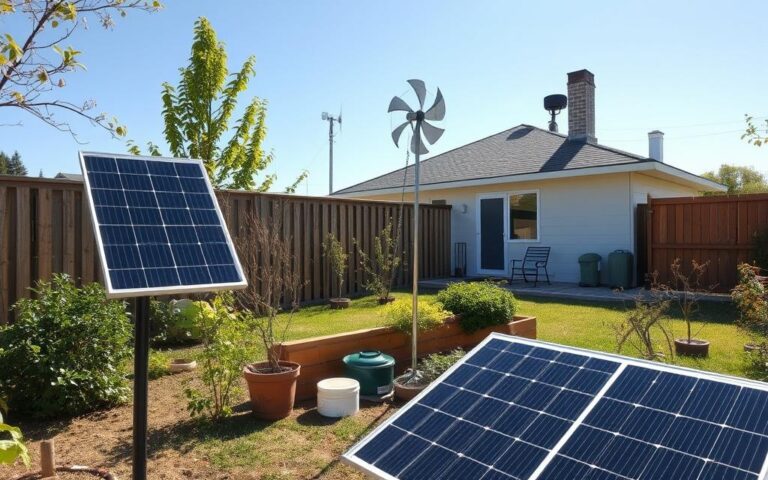
Cities worldwide are undergoing an energy revolution. By 2030, urban areas may generate 60% of their electricity from renewables. Solar energy is leading this shift towards sustainable urban development.
Urban renewable energy tackles climate change and energy security. Solar cities showcase how metropolitan areas can cut carbon emissions. They also build resilient energy infrastructure.
The move to solar cities is both environmental and economic. City leaders see renewable tech as a solution to energy issues. It also creates jobs and improves urban infrastructure.
Advanced solar tech is changing city landscapes. Rooftop installations and building-integrated photovoltaics are common sights. These changes create smart, connected urban energy networks.
Solar cities offer a model for sustainable urban growth. They show how investing in renewables can benefit cities. This approach creates more livable, efficient, and eco-friendly urban spaces.
Understanding Urban Renewable Energy Transformation
Urban energy is evolving rapidly, driven by innovative tech and sustainability goals. Smart energy infrastructure reshapes how cities generate, distribute, and use power. It’s a critical component in this transformation.
Cities worldwide are reimagining their energy ecosystems. They’re integrating renewable technologies into metropolitan environments. This creates advanced urban energy systems for sustainable power.
Defining Smart Energy Infrastructure
Smart energy infrastructure is a network of connected technologies. It optimizes energy efficiency and sustainability. This system has several key features.
- Real-time energy monitoring
- Adaptive grid management
- Decentralized power generation
- Advanced data analytics
Key Components of Urban Energy Systems
Modern urban energy systems use innovative components. These create resilient and efficient power networks. Let’s look at some key elements.
| Component | Function | Impact |
|---|---|---|
| Distributed Solar Panels | Local renewable energy generation | Reduces grid dependency |
| Smart Meters | Energy consumption tracking | Enables precise demand management |
| Battery Storage Systems | Energy storage and stabilization | Improves grid reliability |
Current Global Energy Trends
Global energy trends show a shift towards renewable solutions. Cities are adopting integrated approaches for sustainable power. These focus on several key areas.
- Carbon neutrality
- Renewable energy adoption
- Energy efficiency improvements
- Digital grid technologies
“The future of urban energy lies in smart, interconnected, and sustainable systems that transform how we generate and consume power.” – Clean Energy Institute
Urban centers continue to grow rapidly. Smart energy infrastructure will create more sustainable cities. It will also make them more efficient and resilient.
Solar Technology Integration in Modern Cities
Urban solar integration has changed city landscapes. It’s revolutionizing how cities approach renewable energy. Photovoltaic systems now go beyond traditional rooftop installations, offering innovative solutions across urban areas.
Cities worldwide are using cutting-edge solar technology to tackle energy challenges. These advanced approaches are reshaping urban environments.
- Integrated solar panels in building facades
- Solar-powered street furniture
- Transparent solar windows
- Solar roadways and pedestrian pathways
Urban solar integration does more than just generate energy. Smart cities are creating multifunctional solar technologies with multiple benefits.
These technologies generate electricity, provide shade, and enhance architectural beauty. They’re transforming cities into more sustainable and attractive places.
| Solar Technology Type | Urban Application | Energy Efficiency |
|---|---|---|
| Building-Integrated Photovoltaics | Architectural Surfaces | 15-20% |
| Solar Street Furniture | Public Spaces | 8-12% |
| Solar Roadways | Transportation Infrastructure | 5-10% |
Solar technology keeps evolving, blending urban infrastructure with renewable energy solutions. Photovoltaic systems are crucial in making cities more sustainable.
They’re reshaping urban energy landscapes and paving the way for a greener future. The potential for solar integration in cities is vast and exciting.
Building-Integrated Photovoltaics (BIPV): Revolutionizing Urban Architecture
Solar architecture is evolving with building-integrated photovoltaics (BIPV). This technology blends solar energy generation into architectural design. BIPV replaces traditional building materials with solar-generating surfaces.
BIPV technology is a major leap in sustainable urban design. It offers several benefits for modern construction:
- Aesthetic integration with architectural styles
- Dual-purpose functionality as building material and energy generator
- Reduced overall construction and energy costs
- Enhanced building energy efficiency
Innovative BIPV Applications
Architects are exploring creative BIPV uses across various building parts. Solar windows generate electricity while staying clear. Solar roof tiles match traditional roofing materials perfectly.
Facade systems turn entire building exteriors into powerful energy-producing surfaces. These innovations are changing how we think about building design.
Cost-Benefit Analysis of BIPV Systems
BIPV systems may cost more upfront, but they offer big long-term benefits. Energy savings and lower carbon footprints make them attractive.
Government incentives can also make BIPV systems more appealing to urban developers. The initial investment often pays off over time.
Future BIPV Developments
Research is expanding the potential of building-integrated photovoltaics. New technologies promise better efficiency and more design options. These advances point to a bright future for renewable urban energy solutions.
Sustainable Urban Planning and Energy Districts

Sustainable urban planning transforms cities into energy-efficient powerhouses. It’s a practical approach to redesigning metropolitan landscapes. Energy districts connect buildings and systems to optimize energy use and production.
Cities are pioneering innovative approaches to sustainable urban planning. They use several key strategies:
- Integrated renewable energy infrastructure
- Smart zoning regulations supporting green development
- Advanced building codes promoting energy efficiency
- Financial incentives for sustainable urban design
European cities like Copenhagen and Amsterdam lead in creating successful energy districts. They show how planning can reduce carbon footprints and enhance urban livability. The transformation goes beyond environmental benefits.
It creates economic opportunities and improves residents’ quality of life. Key components of effective energy districts include:
- Decentralized energy generation systems
- Intelligent grid management technologies
- Community-based energy sharing networks
- Integrated renewable energy sources
The future of urban development focuses on holistic sustainable planning. It views energy as an integrated ecosystem, not a standalone utility. This approach covers production, distribution, and consumption.
Smart Grid Technologies and Urban Energy Management
Urban energy systems are changing fast. Smart grid technologies are key for modern cities. These networks use advanced tech to optimize power distribution and use.
Smart grids help cities create better energy systems. They use digital communication and monitoring. This improves urban energy infrastructure dramatically.
Grid Modernization Strategies
Cities are using new strategies for energy challenges. These include:
- Advanced metering infrastructure
- Real-time energy monitoring systems
- Integrated renewable energy networks
- Predictive maintenance technologies
Energy Storage Solutions
Energy storage is crucial for urban energy management. New solutions help cities manage renewable energy sources better.
| Storage Technology | Capacity | Efficiency |
|---|---|---|
| Lithium-Ion Batteries | 100-500 MWh | 85-95% |
| Thermal Storage | 50-250 MWh | 70-85% |
| Pumped Hydro Storage | 500-1000 MWh | 70-80% |
Demand Response Programs
Demand response programs are changing urban energy use. These initiatives incentivize consumers to adjust their energy usage during peak periods. This helps balance grid load and reduce energy strain.
Smart grids create a dynamic energy landscape. They use advanced monitoring and management systems. This helps cities achieve better energy efficiency and sustainability.
Urban Renewable Energy: Challenges and Solutions
U.S. cities face big hurdles in reaching clean energy goals. The shift to urban renewable energy requires new ideas to beat complex barriers.
Key challenges in implementing renewable energy solutions include:
- Limited urban space for solar and wind installations
- Complex grid integration requirements
- High initial infrastructure investment costs
- Regulatory and policy constraints
Cities are finding smart ways to tackle these energy issues. They’re coming up with creative plans to make progress.
- Rooftop solar panel integration
- Virtual power plant networks
- Peer-to-peer energy trading platforms
- Advanced energy forecasting technologies
New tech is changing how cities use energy. Distributed energy resources and smart grids are making urban power more flexible.
These tools help cities adjust to changing energy needs. They also make the power supply more reliable.
| Challenge | Innovative Solution |
|---|---|
| Space Constraints | Building-Integrated Photovoltaics |
| Grid Stability | Advanced Energy Storage Systems |
| Regulatory Barriers | Policy Redesign and Incentive Programs |
Cities are focusing on sustainable infrastructure more than ever. To succeed, they’ll need help from tech experts, lawmakers, and community members.
Working together, these groups can find solutions to urban energy problems. Their teamwork will shape the future of city power systems.
Economic Benefits of Urban Solar Implementation
Urban solar economics transforms city infrastructure and sustainable development. U.S. cities are finding financial advantages through strategic investment in solar technologies. This approach offers multiple layers of financial opportunity and community growth.
Green jobs are a critical part of this economic revolution. They create new career paths and boost local economies. The solar energy sector generates employment across various skill levels.
Job Creation and Green Economy
Solar energy sectors are generating substantial employment opportunities across various skill levels:
- Solar panel installation technicians
- Research and development specialists
- Manufacturing professionals
- Energy system maintenance workers
Property Value Enhancement
Solar installations boost property valuations. They make real estate more attractive to environmentally conscious buyers.
| Property Type | Average Value Increase |
|---|---|
| Residential Homes | 4.1% – 6.5% |
| Commercial Buildings | 7.2% – 9.8% |
Municipal Cost Savings
Cities investing in urban solar infrastructure see long-term financial benefits. Renewable energy investment cuts municipal energy costs while creating sustainable infrastructure.
“Solar technologies are not just an environmental solution, but an economic strategy for urban growth.” – Clean Energy Research Institute
Smart solar implementation can lead to significant municipal savings. This allows cities to redirect funds toward community development and public services. It also supports infrastructure improvements.
Conclusion: The Future of Solar Cities and Urban Renewable Energy
Solar technologies are reshaping urban landscapes across the United States. They’re practical solutions for sustainable, resilient cities. The future of solar cities depends on integrating advanced tech with smart infrastructure design.
AI and new materials are speeding up the shift to sustainable urban living. Cities like San Francisco and New York are cutting carbon emissions with renewable energy strategies. These investments in solar infrastructure are transforming urban areas.
Teamwork is key to the urban energy revolution. Local governments, tech companies, and residents must work together on renewable energy solutions. Clean energy tech can create more livable, eco-friendly cities that inspire others worldwide.
Solar cities have huge potential as technology improves. New photovoltaic systems and smart grids will change how cities use energy. This shift isn’t just about tech; it’s about rethinking our connection to energy and nature.
FAQ
What are urban renewable energy solutions?
Urban renewable energy solutions are innovative ways to generate clean energy in cities. They focus on solar power, wind energy, and sustainable infrastructure. These solutions reduce carbon emissions and boost urban energy efficiency.
How do Building-Integrated Photovoltaics (BIPV) work?
BIPV systems blend solar tech into building structures like windows, facades, and roofs. They generate electricity while keeping the building’s look and function intact.
What are the economic benefits of urban solar implementation?
Urban solar creates jobs in the green energy sector. It increases property values and cuts energy costs. Cities save money and enjoy long-term environmental health perks.
What challenges do cities face when implementing renewable energy?
Cities struggle with limited space and complex grid integration. They need major infrastructure upgrades and face regulatory hurdles. Virtual power plants and advanced forecasting help tackle these issues.
What is a smart grid?
A smart grid is an advanced electrical system using digital tech. It manages electricity distribution and integrates renewable energy sources efficiently. Smart grids optimize energy storage and enable demand response programs.
How do energy districts contribute to sustainable urban planning?
Energy districts link buildings and systems to optimize energy use. They create efficient urban spaces that cut energy waste. These districts promote sustainable development in cities.
What role does energy storage play in urban renewable energy?
Energy storage, like advanced batteries, is key for urban renewable energy. It manages intermittent power sources and ensures stable supply. Storage helps balance energy demand in cities.
Can solar technology be implemented in dense urban areas?
Yes, dense urban areas can use solar tech in creative ways. Options include rooftop panels, solar facades, and solar windows. Even solar-powered street furniture can maximize limited space.
What are demand response programs?
Demand response programs encourage smart energy use during peak hours. They help balance energy supply and demand. These programs reduce grid stress and promote efficient energy consumption.
How do cities benefit from renewable energy technologies?
Renewable energy boosts city energy security and cuts carbon emissions. It lowers energy costs and creates jobs. Cities enjoy better air quality and more sustainable environments.




